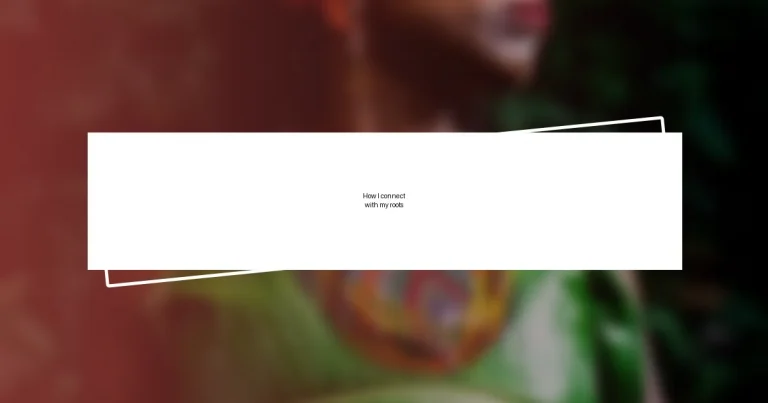Key takeaways:
- Engaging with cultural traditions and family stories fosters a deep sense of identity and connection to one’s roots.
- Researching family history through various methods, including online resources and local archives, enhances understanding of personal heritage.
- Participating in community practices and cultural events strengthens bonds within the community and enriches shared cultural narratives.
- Incorporating traditions into daily life, such as cooking and storytelling, fosters belonging and preserves familial legacies for future generations.

Understanding my cultural background
Understanding my cultural background has been a journey, filled with moments that have shaped who I am. I recall sitting at my grandmother’s kitchen table, the air thick with the aromas of spices simmering on the stove. As she shared stories from her youth, I couldn’t help but feel a deep connection to a past that felt almost tangible. Have you ever had that feeling where your heritage speaks to you through the tales of those who came before?
Each tradition we celebrate offers a window into the values and beliefs that have been passed down. For instance, during family gatherings, we gather around not just to eat, but to exchange stories that bind us. It’s as if each narrative weaves a thread connecting me to my ancestors. I often ponder, what does it mean to carry their stories? It’s a powerful reminder that I don’t just exist in isolation; I’m part of a larger tapestry.
Through understanding my roots, I’ve embraced aspects of my culture that resonate with me. I vividly remember the first time I participated in a traditional festival. The vibrant colors, the rhythmic music, and the laughter of familiar faces made me realize that my background isn’t just something I cherish; it’s an active part of my identity. How many of us truly take the time to explore and celebrate those elements that make us who we are? Each discovery reveals a piece of myself that was waiting to be uncovered.

Researching family history
Researching family history can often feel like embarking on a treasure hunt, uncovering pieces of our identity hidden in dusty records and old photographs. I recall one afternoon spent sifting through my parents’ attic and stumbling upon a worn, leather-bound family tree. Each scrawled name represented a life, a story, and a legacy that felt intertwined with my own. Isn’t it fascinating how a simple name can evoke a sense of belonging and connection across generations?
As I delved deeper, I turned to online resources like Ancestry and familysearch.org, which opened up a vault of information I never knew existed. I remember feeling both exhilarated and overwhelmed as I navigated through census records and historic documents. I discovered relatives I never knew about, some of whom came from distant lands, carrying dreams and struggles of their own. Does anyone else feel that thrill of piecing together parts of our family puzzle? It’s as if I’m not just reading about them; I’m tapping into their hopes and triumphs, bridging the gap between past and present.
In my experience, visiting local archives and libraries proved invaluable. I remember the day I sat in an archive, surrounded by the soft rustle of pages, and uncovered letters exchanged between my great-grandparents during their courtship. The love and challenges they faced painted a vivid picture of their lives, allowing me to feel their emotions in ways that mere facts couldn’t convey. It left me wondering, how many layers of our family stories remain yet to be discovered? Researching family history is not just about gathering facts; it’s about forming a connection that enhances our understanding of who we are today.
| Method | Description |
|---|---|
| Online Resources | Websites like Ancestry offer extensive databases to track lineage. |
| Local Archives | Visiting libraries or historical societies can provide unique insights and documents. |
| Personal Interviews | Talking to family members can reveal invaluable personal stories and connections. |

Exploring ancestral traditions
Exploring ancestral traditions has enriched my understanding of who I am and where I come from. I’ll never forget the first time I attended a community celebration, where we honored our cultural heritage through music, dance, and food. The vibrant energy in the air felt intoxicating. I felt a rush of emotion as I watched my family engage in age-old customs; it was as if the spirits of my ancestors were present, guiding us. Connecting with these traditions created a strong sense of identity, reminding me that I am part of something much larger.
- Participating in traditional dances taught me the rhythms of my culture.
- Preparing family recipes has turned into a cherished ritual, connecting me to generations of home cooks.
- Listening to elders share tales of our ancestors’ struggles and triumphs deepened my appreciation for their sacrifices.
Every time I engage with these practices, I gain a deeper perspective on my roots, making each experience not just enjoyable but profoundly meaningful. Isn’t it fascinating how these traditions serve as anchors in our fast-paced lives?

Connecting with community practices
Connecting with community practices has always been a meaningful aspect of my journey to understand my roots. One of my most vivid memories is participating in a local festival where artisans showcased traditional crafts. I can still remember the way the air smelled of fresh paint and wood shavings, and how I felt a surge of pride watching my community weave stories into tangible form. Doesn’t it make you ponder how creativity can tie us all to our ancestors, their skills echoing in every handmade piece?
On another occasion, I volunteered at a community garden that celebrated heritage plants. As I dug my hands into the soil, I felt an overwhelming connection to the generations who cultivated this land long before me. It made me wonder: how often do we overlook the simple yet profound ties that bind us through shared labor and growth? Every plant seemed to whisper tales of resilience, reminding me that nurturing these connections is as vital as tending to the garden itself.
Engaging in community service projects has deepened my appreciation for the values that shape our collective identity. I remember a day spent helping to organize a cultural exhibition that featured music and storytelling from our heritage. As I watched elders share their experiences with the younger generation, I felt a wave of warmth and understanding. It urged me to ask myself, what responsibilities do we have to preserve these beautiful traditions for future generations? It’s this reciprocal relationship within our communities that enriches our lives, allowing us to honor our past while sowing seeds for tomorrow.

Engaging in cultural events
Engaging in cultural events has provided me with some of my most treasured memories. I remember attending a vibrant Diwali celebration, where the air shimmered with the scent of spices and sweet treats. Surrounded by colorful decorations and laughter, I found myself lost in the stories shared around the fire, connecting with both my cultural heritage and the community. Isn’t it remarkable how a single evening can unfold like a tapestry, weaving together different lives and experiences?
One particularly moving moment was when I participated in a local dance contest featuring traditional folk performances. As I stepped onto the stage in my family’s traditional attire, my heart raced with a mixture of pride and vulnerability. The rhythm of the music seemed to resonate in my bones, reminding me of the countless evenings spent with my grandmother, learning each step and twirl. How can something as simple as dancing hold such profound connections to our roots? That night, under the spotlight, I felt not just like an individual, but a living branch of a much larger family tree.
Every cultural event brings a unique opportunity for learning and reflection. I recall volunteering at a cultural fair where elders demonstrated traditional crafts like weaving and pottery. I was mesmerized by their skill and patience, crafting beautiful items with stories woven into each strand. It made me think about the balance between tradition and modernity. How do we preserve these intricate stories in a world focused on speed and convenience? Engaging in these events is more than participation; it’s a commitment to honoring our past and ensuring that the vibrant pages of our cultural history continue to be turned for generations to come.

Incorporating traditions into daily life
Incorporating traditions into daily life often feels like a dance that weaves past and present together. One of my cherished routines is cooking traditional recipes passed down through generations. I can vividly recall the first time I tried making my grandmother’s signature dish. The scent of spices filled the kitchen, transporting me back to her warm home, where I learned to appreciate not just the food, but the love and history behind each ingredient. Isn’t it fascinating how a simple recipe can anchor us to our ancestors, reminding us of who we are?
Another way I weave tradition into my daily life is through storytelling. I often find myself gathering with family during weekends to share tales from our heritage. As we huddle around the dining table, I see the sparkle in my children’s eyes as they listen to stories of bravery, wisdom, and humor that shaped our family history. Each narrative seems to breathe life into the past, prompting me to wonder: how can we create a sense of belonging without these shared experiences? It is in these moments that I feel the powerful bond of connection across generations—a reminder that our stories are not just ours, but part of a larger narrative.
I also make a conscious effort to celebrate traditional holidays with all their rituals and customs. I remember one winter, when we brought out decorations for a festival that has been celebrated in our family for decades. Hanging the ornaments with my kids not only filled our home with joy, but it sparked conversations about what each ornament meant and the memories tied to them. This practice felt vital; it made me reflect on the question: what legacy do we leave if we forget to celebrate and honor where we come from? Engaging in these traditions daily fosters a deeper sense of identity, enriching our lives with cultural richness that resonates far beyond the moment.

Sharing my journey with others
Sharing my journey with others has been one of the most rewarding aspects of reconnecting with my roots. I often find myself sitting around a cozy fire with friends, recounting tales from my childhood that echo the vibrant history of my culture. It’s in those moments that I notice their eyes light up, resonating with the shared experience. Have you ever felt how stories can create bridges between hearts and generations?
One evening, I shared my family’s unique practice of writing letters to our ancestors during significant milestones. The reactions were mixed—some found it unusual, while others felt inspired to do something similar. Seeing their curiosity sparked a deeper conversation about how roots shape our paths. It made me realize just how powerful our stories are. I wonder: why do we often shy away from sharing these intimate parts of ourselves? Perhaps it’s because we fear judgment, yet I’ve found that vulnerability fosters understanding and connection.
Additionally, organizing community gatherings has allowed me to share my heritage in a more tangible way. Last summer, I facilitated a multicultural potluck where everyone was encouraged to bring a dish that represented their family history. The room buzzed with excitement as individuals shared not just recipes but the stories behind them. I watched as connections formed between people from diverse backgrounds, united by the simple act of sharing a meal. Isn’t it fascinating how food can serve as a universal language, telling tales of love, resilience, and tradition? By inviting others to join my journey, I’ve discovered that the more we share, the richer our collective experience becomes.














